Your login information returned multiple users. Please select the user you would like to log in as and re-type in your password.
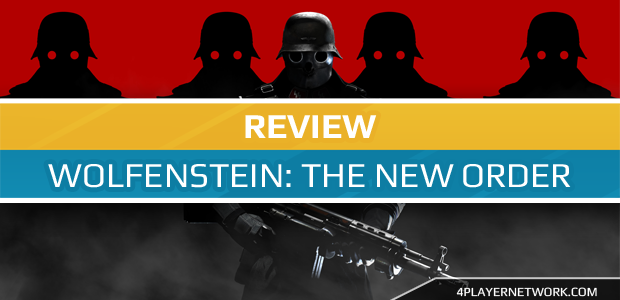
One of the most common things people will complain about in the film industry is that there is no originality left in Hollywood. Though I wish I could argue otherwise, the same can often be said about video games. Too often these days we see one semi-original game come out and, in the half decade following it, publishers release a slog of conformity hoping to recreate the greatness that was that single title. In the ensuing aftermath, older ideas are tossed by the wayside, discarded as if doing otherwise would be an insult to the player’s intelligence. It’s a shameful practice but it’s also a reality we have to face daily. Such is the fate of the shoot ‘em up, the side scrolling beat ‘em up and the run-and-gun unrealistic shooter.
However, every now and then we get a throwback to that golden age when design decisions came more out of necessity than choice, when triple-A titles didn’t have to conform themselves to as common an audience as possible and when developers weren’t being pushed by publishers to make the next great cash cow of a game. These titles are excellent time capsules that remind us of an age gone by but the truly impressive ones are those that manage to bridge the gap between old and new and do so well. Wolfenstein: The New Order from freshman developer Machine Games want to be that rare blue moon of a title.
With five years having passed since the last title in the series and a triple-A industry devoted to creating the next Call of Duty, Grand Theft Auto or the League of Legends killer, does The New Order have the strength to remind our games’ publishers that victory doesn’t have to be found by copying in the present but instead looking to the past?
Developer: Machine Games
Publisher: Bethesda Softworks
Release date: May 20, 2014
Platform(s): Xbox One (Reviewed), PS4, PC, PS3, Xbox 360
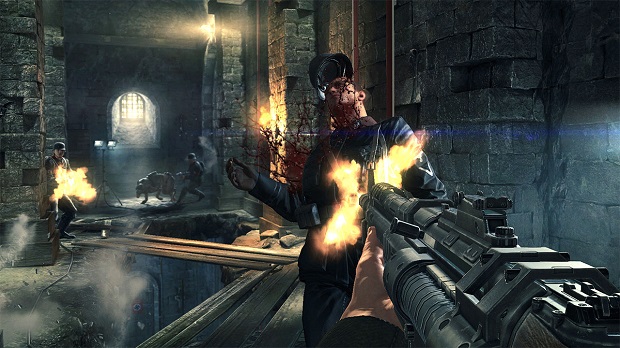
When The War Was Lost
At the break of dawn on July 16th, 1946, more than a year after our Allies defeated the fascist Nazi army, the armed forces of the free world mount a desperate attack on the fortress of General Wilhelm "Deathshead" Strasse, one of the most powerful men in the Nazi army. Where once the Allied powers pressed the advantage, the Germans have turned the tide and are driving their enemies back to the sea thanks to unprecedented advanced technologies of unknown origin. General Deathshead is believed to be the mastermind behind the Nazi’s radical new weaponry and at the spearhead of this last-ditch assault stands Captain William “BJ” Blazkowicz, the Office of Secret Actions agent responsible for defeating him twice before.
Though the allies make a valiant effort, the mission is ultimately a failure. Blazkowicz finds him blast out to sea, taking shrapnel to the head and leaving him in an almost vegetative state. Trapped in his own body, BJ watches with flickering consciousness as the world goes on around him from inside an insane asylum in Poland. What seems like minutes or days passing is, in reality, months and years and before he even knows it he finds himself finally waking up in 1960, fourteen years after his final mission. The German empire, once on the ropes, now rules the world and the people under their thumb suffer for it. Free of his comatic prison, Blazkowicz resolves to find the resistance and get back to doing the one thing he is remarkably gifted at: killing Nazis.
Any shooter fan out there with a reasonably decent head on their shoulders can tell you that the Wolfenstein series has never been known for its narrative capacities. After all, as the granddaddy of the first person shooter, its origins are derived from a time in which the most common installation methods were either by three and a half inch floppy discs or via shareware. Needless to say, when your game is meant to be a technology demonstrator with a focus on gunning down fascists, one shouldn’t exactly expect a focus on story development. Though the series received a story-focused sequel in 2001 with Return to Castle Wolfenstein which reboot the series, the only entry to arrive after that was Raven Software’s singularly-named Wolfenstein in 2009. That title suffered from a horrendously-developed multiplayer component and an extremely divisive sandbox hubworld design so, given that title’s poor sales figures, it’s reasonable to suggest that any new Wolfenstein game would ignore the previous entries and try to establish its own continuity.
The New Order is not such a game. Rather, at many instances it scoffs at the notion of ignoring what has already been established. The game, instead, readily acknowledges the events of Return to Castle Wolfenstein and its 2009 sequel. Old friends and antagonists return, once fought enemies receive a fresh coat of paint and a new suit of armor while BJ and crew actively mention key moments from both previous titles. I find it remarkable that a freshman developer would go the lengths to actively both establish continuity with an already obscurely-connected storyline while at the same time progressing it to a place that allows for a considerable amount of freedom so I must take my hat off to the folks at Machine Games.
Though this may be the first title for this developer, its aptitude for creating a story shouldn’t come as a surprise. Machine Games, opened only in 2009, was founded by key employees of Starbreeze Studios, specifically the teams responsible for The Darkness and The Chronicles of Riddick. These guys know how to make a story but, more importantly, they know how to tell one.
Wolfenstein: The New Order’s story is, admittedly, a decent one but what really makes it stand out is the format by which it is told. Though mostly a traditional first person title, the game is interspersed with a fair amount of cutscenes that do well to compliment the action without taking the player out of the moment. At several moments throughout the game the control is taken out of the player’s hands for an interactive moment, usually forcing the player to make a decision. These scenes are fantastically told and acted, making them a strong narrative highlight.
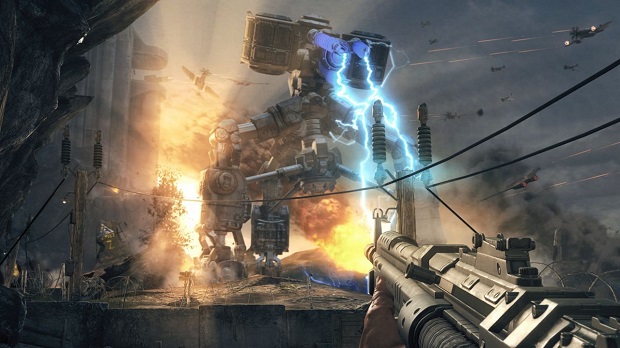
The best part of the story, however, is the narration. BJ Blazkowicz, or any id Software-originating character for that matter, have never been known for their storytelling prowess but Machine Games has channeled their pedigree and brought us narration in the same manner we got in The Chronicles of Riddick and The Darkness. The results are simply wonderful as it turns out as BJ Blazkowicz is a remarkably introspective character. As he continues on his vengeful stride against General Deathshead, his comments on the terrible crimes of the Nazi war machine while reflecting upon his own personal losses and hatred for the man are terrifically done thanks to a rather spectacular performance by a grumbly-voiced Brian Bloom. Everything from a one-liner about cursing the moon for allowing Nazis to land on it to a rather emotional recitation of Emma Lazarus’ The New Colossus are wonderfully done. Though one wouldn’t expect it, the game’s dialog easily stands shoulder to shoulder with many great recent titles such as The Last of Us, Bioshock Infinite and even Half-Life 2.
Despite featuring a few plot holes here and there as well as forcing the player to discover most of the events that occurred during BJ’s fourteen year absence, Wolfenstein: The New Order is a very well done story to experience.
Return of the Tempest-Tost
If we’re honest with ourselves, the shooter formula of the past eight year has followed a singular model: shoot bad guys from cover, duck behind cover to heal for a time, rinse and repeat. It seems that the days of the shooter being about mad dashes and precision aim with crazy weapons is gone but Wolfenstein: The New Order looks back on those days with a fond eye. Rather than ditch one formula for another however, this title instead tries to meld two to a surprising amount of success.
At its heart, much of The New Order is built around a soft cover-based combat system similar to that of Killzone in which pressing up against cover and simply pulling the left trigger allows you to aim down sight over the edge of your cover. Alternatively, players can press and hold the left bumper (L1) and contextually lean as they see fit, allowing for quite a bit of freedom in sticking to one spot. It’s a very easy to use system and I hope that developers take notice of it and try to incorporate it into their own shooter franchises.
This new Wolfenstein, however, comes from a pedigree of classic run-and-gun shooters and it readily acknowledges this fact by making such a playstyle a very acceptable option. Players have the ability to sprint, slide and blow away enemies with dual-wielded weapons such as assault rifles or even automatic shotguns because to hell with logic, it’s fun! Most encounters you will find will facilitate using both playstyles but one would imagine that today’s laser-accurate enemies would quickly turn you into a pile of human mush but this is in fact not so thanks to the games abundance of support elements.
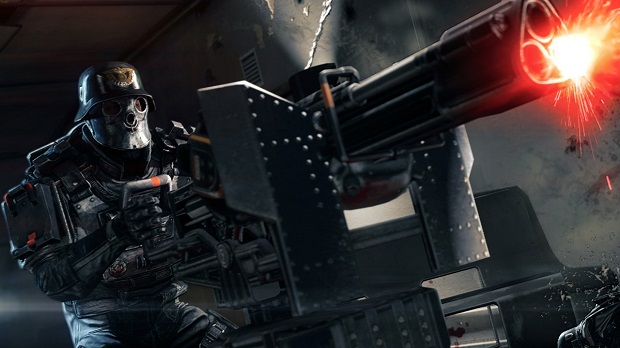
Once again taking notes from two different eras, The New Order features a rarely-used segmented regenerating health system to keep BJ in the fight. Health regenerates in bunches of twenty and can be healed further by finding health pickups such as medkits and food that are littered throughout the world. The interesting part of the health system players should take note of is that it automatically regenerates health to the next increment of twenty so, for example, if you happen to pick up five health when you are at 60, it automatically takes that and pushes you to 80. Quite easily, one can regain most or all of their health bar by simply waiting for the regen segments to complete before picking up another health item. In addition, players can overcharge their health in a similar manner to that of old school competitive shooters such as Quake, allowing you to boost it as much as you want through health items at the cost of it slowly degenerating until it returns to you max health limit. Overall it’s a very smart and easy to use system that keen players will take advantage of if they think their actions through rather than just running and picking up items all willy-nilly.
Taking another page from today’s playbook, Wolfenstein incorporates a perk skill system. Earned in the same manner as achievements are done nowadays, players can unlock these perks by doing certain actions such as getting five kills within ten seconds with a detached turret or overcharging their health to two hundred. Dying in the middle of a firefight or restarting from a checkpoint does not take away the overall count you’ve been working toward so it is quite easy to actually grind toward earning these permanent character attributes. Yes, you read that right: you’re grinding in a first person shooter.
One interesting element that Machine Games decided to incorporate is the Area Commander, a Nazi officer in charge of certain sections of maps. These officers will radio for help upon seeing you, spawning waves of reinforcements and making a previously normal combat scenario significantly harder. It is here that we are introduced to an element that has never really been a significant part of any Wolfenstein game: stealth. As with these Area Commander sections, most of the levels in The New Order feature at least several points on a map in which the player is strongly encouraged to stealth the area. Stealth can be easily accomplished thanks to the inclusion of throwing knives, silent yet violent takedowns as well as a silencer for your pistol. Stalking enemies through hallways even atop the occasional rooftop feels quite satisfying, once again channeling Machine Games’ strong past when they worked at Starbreeze. Heck, this might be the closest stealth fans may get to Dishonored 2 when/if it sees the light of day years from now. It’s a rather simplistic system, to be sure, but it works quite well and doesn’t completely discourage the player from wanting to slaughter them all with hails of bullets.
Wolfenstein’s level design once again harkens back to more classic ideas of segmented level design, bookending each level with a cinematic that is player-triggered rather than timed or scripted. The levels themselves are, for the most part, quite linear but stay true to the spirit of the classic id Software titles with a bunch of things to find and explore. Hidden passageways, alternate routes and various other secrets abound throughout the game and really encourage exploration before moving on. The levels themselves tend to be quite varied in their architecture with maps ranging from a London-based museum dedicated to Nazi space exploration, to a visually (and wisely) neutered concentration camp. No two areas ever feel alike which I found to be quite enjoyable.
Replay value is quite strong for Wolfenstein: The New Order thanks to a series of collectibles as well as an interesting branching system. Throughout each map you can find multiple different collectibles such as Enigma Codes (collecting all in a series will unlock a new gameplay mode), letters written by the inhabitants of the world, weapon upgrades and, of course, gold and jewels. The true replay value for The New Order doesn’t come from these elements. Rather, it is the aforementioned branching system known as Timelines.
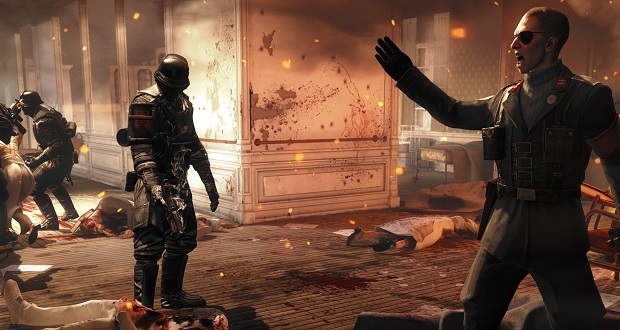
In the first mission of the game, players are forced to make a decision that results in the death of one of two characters. In turn, that shifts the game’s direction into a timeline. Though the vast majority of the game remains the same between the two timelines, small yet quite noticeable differences appear throughout the experience. You learn a different exploration skillset, certain areas of a map are in/accessible, cinematics are presented in a slightly different manner, side-story characters are replaced and levels even sometimes branch in different directions, though always toward the same inevitable outcome. It’s a really interesting way to approach replayability beyond simply adding a new mode or difficulty level to the mix and the results are appreciated. Machine Games seems intent on making your journey in the shoes of BJ Blazkowicz one that’s simply not over after a single playthrough and they make a strong argument for diving right back in after the credits roll.
Wolfenstein’s gameplay, as a whole, is a rather great experience with the only really prominent flaw being Machine Games’ world building. Outside of the central plotline, most of the backstory about characters in the world as well as how the Nazis took over the planet during BJ’s fourteen year slumber is something the player has to actively search the environment for. Even then, lots of questions remain completely unanswered. What happened to the US? Why is Hitler only mentioned once throughout the entire game? What impact do your actions really have on the world and how are other resistance cells faring? These and many other questions remain unanswered by the end of the game though we can probably expect many of them to be things the inevitable sequel should focus on.
The Teeming Shore of the New World
Let’s get this right out of the way: Wolfenstein: The New Order is simply gorgeous. Running on id Software’s proprietary idTech 5 engine, the same one that powered Rage in 2010, the results are spectacular. Unlike Rage, however, this version of the engine features almost no texture pop-in which is something I was previously worried about. Character models look fantastic with only a handful of flat, uninflated textures to be found throughout the environment, but that’s understandable. Terrain destruction is well done and will quickly force corner campers to reposition thanks to the variety of destructible cover available. The cinematics themselves are quite nice thanks to smart framing, great model animations and strong pacing as they don’t beat around the bush in informing the player of what they want/need to know in order to further the plot.
In terms of audio, Machine Games’ has an equal amount of high and low points. As previously stated, Brian Blooms narration of BJ Blazkowicz’s internal monologue is fantastically done as well as that of several of the games antagonists. On the flip side, the actual musical score of the game is strangely downplayed with the exception of a handful of the cinematics. Though the game featured some rather great marketing in the form of German versions of 1960s Americana songs as well as some original pieces, the soundtrack itself feels almost muffled by comparison and contains no real core theme for anybody except Deathshead himself. I find it weird that Mick Gordon, creator of the stellar soundtrack to last November’s Killer Instinct, was unable or not allowed to craft a core theme for BJ, let alone one that reflects his inner anger and sorrow at the events that take place around him. It’s pretty unclear just what happened here but the results are a tad disappointing.
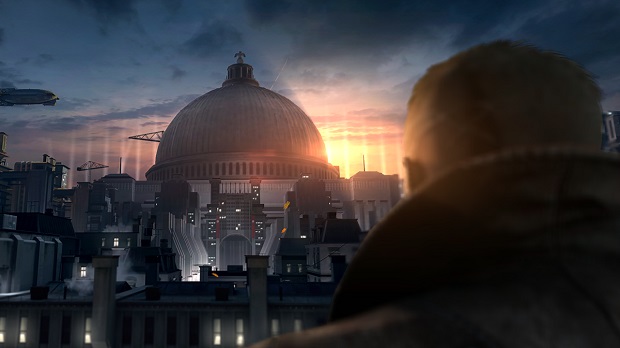
The Torch of Imprisoned Lightning
Wolfenstein: The New Order is a game I would have never expected to play three years ago. An interesting, story-based Wolfenstein game with great character development that felt just as great as its 1992 incarnation? I would have declared that an improbable suggestion. And yet, here we are. The New Order doesn’t break any ground that hasn’t been tread before but instead mixes a lot of great ideas, both old and new, to form a very well-told story. It has its flaws, to be sure, and faces some stiff competition in the coming months but it certainly seems to be the most delightful surprise of 2014. The lesson here is that you don’t have to teach an old dog new tricks: instead, you should let it teach you some old ones.
Final Score: 8/10
(80-89%: Great - Only very minor issues get in the way of greatness.)
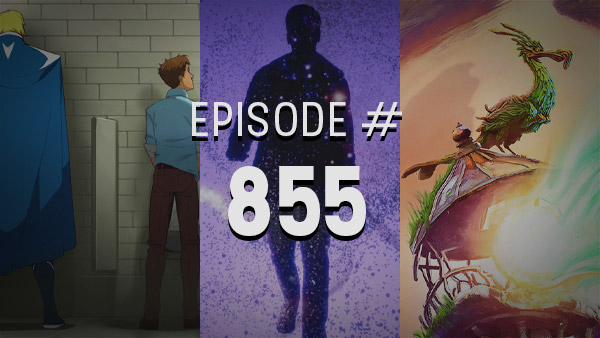

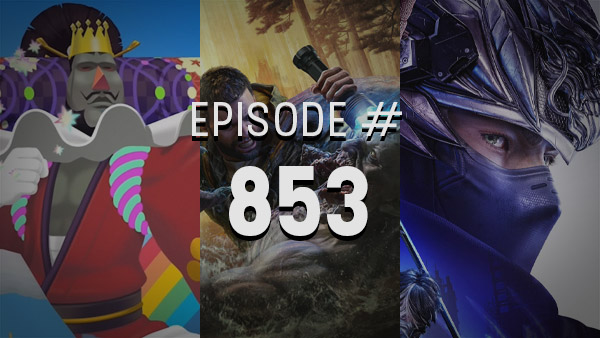

Comments
11 years, 6 months ago
Pretty sweet, Chris. This clarified the details of a few systems I hadn't quite gotten a grasp on. I especially liked the last line in the review, as well.
11 years, 6 months ago
Good review chris good review. I would still give so much for some new ww2 shooters lol.
11 years, 6 months ago
Great review Chris. Was a game I was always going to pick up eventually given it go positive reviews. And yours pretty much seals it up.
11 years, 6 months ago
That was a fine review Chis. Glad to know this game isn't as horrible as several modern games will take on classic games.